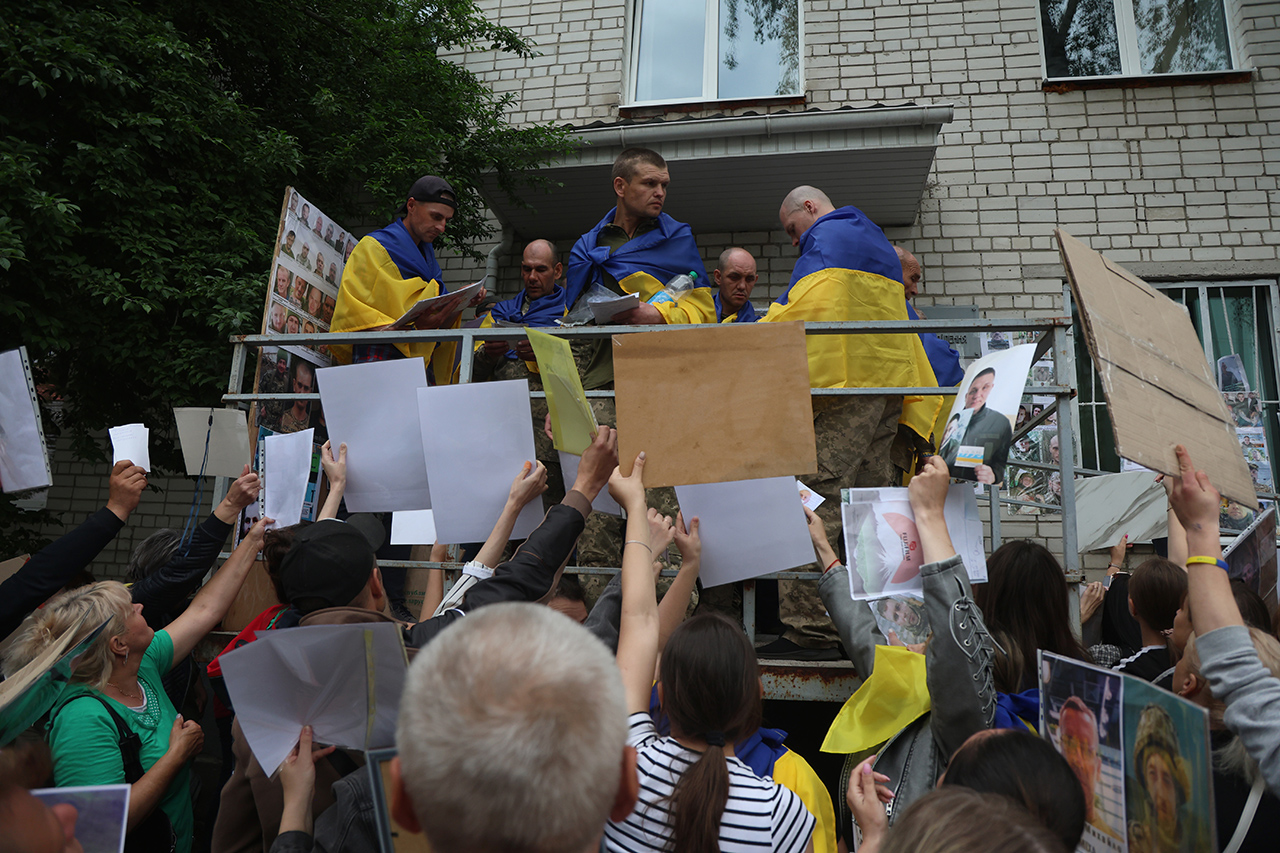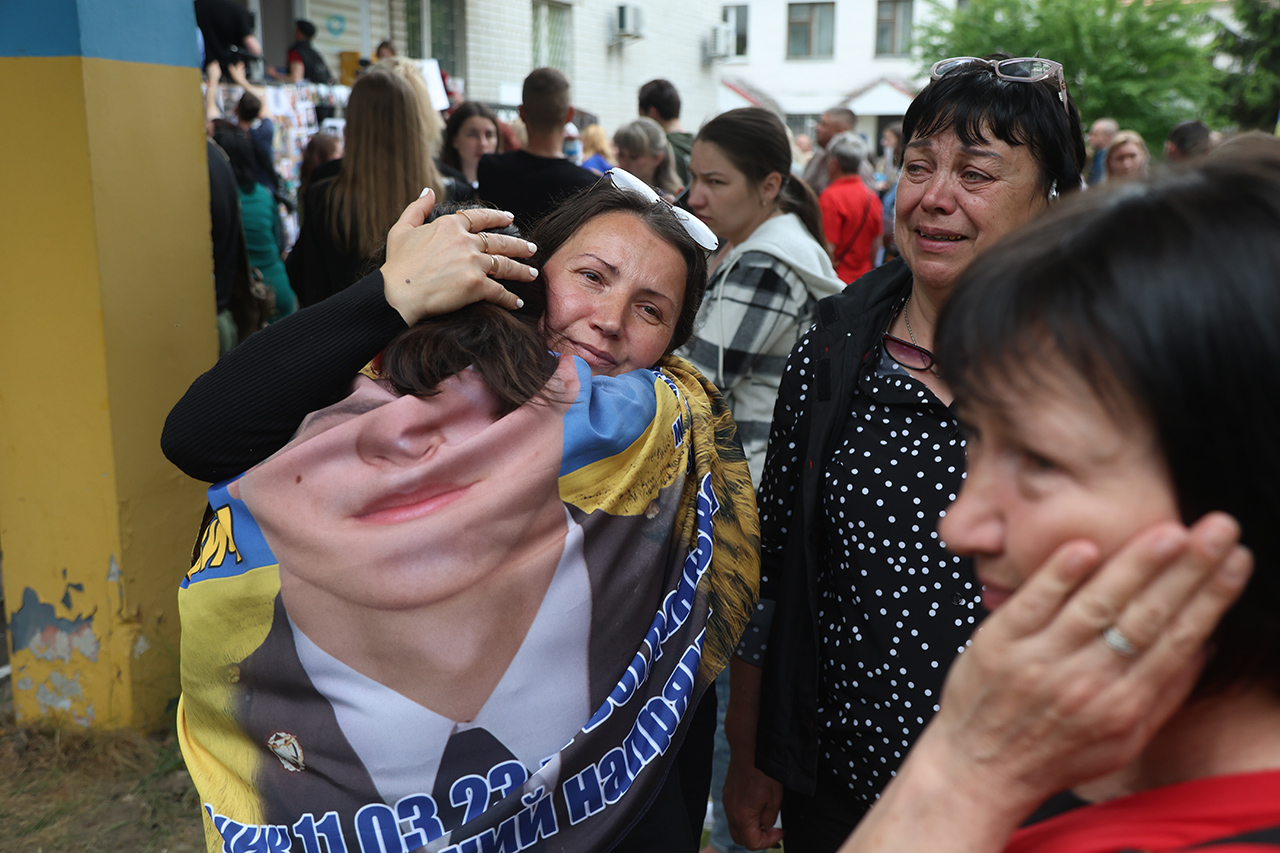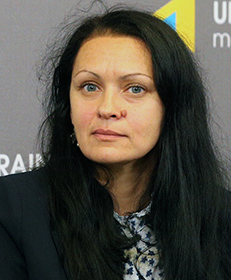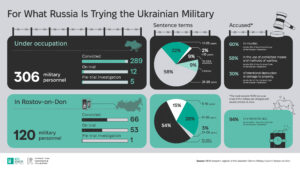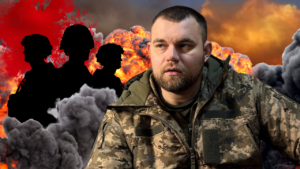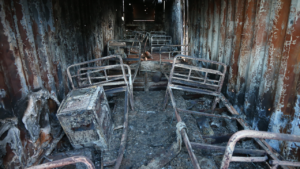The great exchange: a report on how a thousand Ukrainians returned home
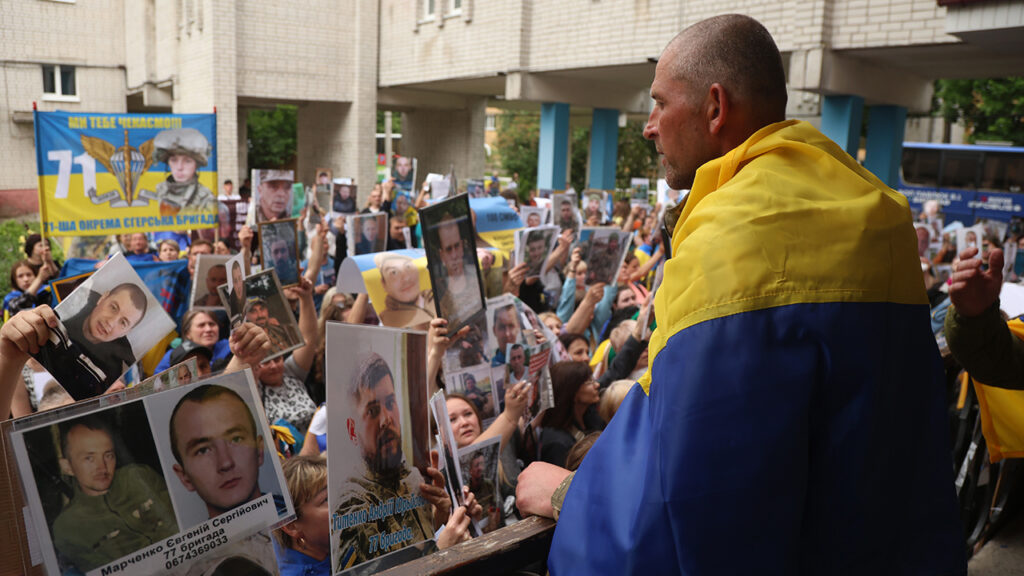
Change clothes, have a wash, and undergo a medical examination. At a temporary medical center in the Chernihiv region, where the recently released Ukrainian prisoners of war are just about to arrive, nurses are preparing to receive ambulances carrying the severely wounded. The doors of the admission ward stand open. A few people in white coats are ready to help navigate the narrow iron ramp. A distant sound of sirens can be heard in the stillness before the rain.
Four ambulance vehicles come from around the corner of the building and stop at the entrance. In the first vehicle, a man lies with both legs amputated below the knee. The second carries a man with severe leg injuries. In the last one, there is a tall man wrapped in the Ukrainian flag wearing a medical mask. He is coughing. An accompanying nurse asks the welcomers to step aside to ensure a clear passage for the wounded.

A former prisoner of war, 24 May 2025. Photo by Victor Kovalchuk, MIHR

Former prisoners of war are first of all taken for medical examination, 24 May 2025 Photo by Victor Kovalchuk, MIHR
These prisoners of war are just three from among the one thousand whose exchange was agreed upon by Ukraine and Russia on 16 May 2025 in Istanbul. 307 prisoners of war were exchanged on 24 May 2025. 390 people including 120 civilians were exchanged the day before. The final group of 303 individuals was exchanged on Sunday.
Photos for identification
Several dozen women — mothers, wives, sisters, and daughters of servicemen who are missing or held in captivity — have gathered in the courtyard. Every woman holds a photograph of a man, either in military uniform or civilian clothing. Beneath the image is a name; on the reverse side — a phone number. Each of them tries to ask the newly released if they heard any names or call signs of those who have been missing for months or even years.
The first man taken out of the ambulance turns in his wheelchair on the hospital porch to look toward the waiting families and cries out: “They will all come home!”
Standing silently by the ramp is a short, dark-haired young woman wrapped in the red-and-black flag bearing the words “The Right Sector Ukrainian Volunteer Corps”. She holds photographs of her husband and of his brothers-in-arms.

Families of the missing wait in hope that the former prisoners of war might bring news of their loved ones. Photo by Victor Kovalchuk, MIHR
“My husband is from the 67th Separate Mechanized Brigade,” Alina responds.
The brigade was formed in 2022 based on the units of the Right Sector Ukrainian Volunteer Corps. Alina’s husband was mobilized in December 2022.

MIHR journalist Tetyana Katrychenko (in the background) speaks with families of the missing and those held in captivity. Photo by Victor Kovalchuk, MIHR
“At first, he was called to a military enlistment office. He went there and submitted his documents. He had never been to war before — just completed his mandatory military service. Then they called again, asking him to turn up with his belongings. So he did. On 10 March 2023, he went missing near Bakhmut. That same day, 34 other servicemen went missing across two other locations.”
There has been no news from or about Alina’s husband since then.
“Only two men from his unit have been released, as far as I know. However, we have learned nothing either from them or from the commander. There is an official investigation into the disappearance, but it contains no real information. The wording is always the same, with only the names and the dates changing,” she adds.
Alina holds onto hope that someone from among those released today will see her husband’s photo, recognize him, and give her the first real news about him.
The buses carrying the released detainees are running late. Among those waiting is Valeria. It’s her third time coming to the reception site. She is trying to learn anything — even the smallest detail — about her Serhii, who came under fire on the Donetsk front line on 30 December 2024. Since then, all contact with him has been lost.
“The command remains silent. I’m just hoping to hear some news here,” she says calmly, her gaze fixed on the green grass of the hospital lawn.
Valeria knows about instances when the recently released prisoners of war recognized those considered missing from photos. Just yesterday, she saw happy mothers and wives. So, her hope gets stronger.
Photo posters
While the buses have yet to arrive, family members begin unfolding improvised posters. “We prepared them yesterday,” says one of the women. Most of those gathered have been here for a second day. If they get no news, they will stay for a third day.

Medical staff help fix the photos of the missing and those held in captivity. Photo by Victor Kovalchuk, MIHR
“Is there any tape left?” one woman asks a nurse. She disappears behind the hospital doors and soon returns with a roll of clear tape.
Yaroslav Orishko, Volodymyr Pytsko, Mykola Voloshyn, Anatolii Vylkul, Dmytro Lesun…an improvised notice board has taken shape near the entrance to the admission ward. Families tape the photos of their missing loved ones there. As space runs out, they fix the pictures directly to the wall.

Pictures of the missing and prisoners of war. Photo by Victor Kovalchuk, MIHR

Pictures of the missing and prisoners of war. Photo by Victor Kovalchuk, MIHR
The sound of engines grows louder as white and blue buses begin to pull into the hospital courtyard. The buses move slowly along the asphalt driveway, where hundreds of relatives stand waiting. They not only hold photographs, but also wave flags of the marines, paratroopers, and border guards.

A bus carrying Ukrainian soldiers released from Russian captivity. Photo by Victor Kovalchuk, MIHR
Defender is released from captivity”
The bus doors open, and the newly freed prisoners of war begin to step out — thin, gaunt, their faces etched with exhaustion, some with hollow, vacant eyes. Some wear prison uniforms and shoes without laces; others are dressed in faded military fatigues.
“Welcome home!” voices echo from all directions.
A young woman with long dark hair runs from one bus to the next. Her name is Olena Yuzvak.

Families stand near the bus carrying Ukrainian soldiers recently released from Russian captivity. Photo by Victor Kovalchuk, MIHR
She is from Haisyn in the Vinnytsia region. Like many other women, today was her second time traveling to meet the released prisoners. She just wanted to support other women, but on the way she received a text message from the Coordination Headquarters — a message of congratulations: Yurii is released from captivity.
Olena finds her husband and hugs him tightly, shielding their reunion behind a curtain of dark hair. Moments later, she calls their children — 7-year-old son and 9-year-old daughter — on video.
Near another bus, Kateryna reunites with her brother, Dmytro Havrylenko, a soldier of the 46th Air Assault Brigade. He went missing in the Maryinka sector at the end of 2023. She embraces him with one arm while making a call with the other. “He’s here. Keep moving forward.” “His wife and son are coming. They split up to look for him and got lost in the crowd,” she says to the journalists.
“Tymur, Tymur!”
“Daddy!”
A woman’s voice trembling with tears: “Did you recognize your dad? You did!” Their little boy of about five years old looks frozen being overwhelmed by the intensity of the moment and the sea of unfamiliar faces.

Daddy’s hugs after captivity. Photo by Victor Kovalchuk, MIHR
Unlike Olena, Kateryna had learned about her brother’s return a little earlier.
The family soon grows weary of the media attention. They step aside and ask not to be disturbed.
“Every person who is freed is a drop of our soul, a drop of hope,” says an older woman holding a portrait of her husband in her hands. She hasn’t learned anything about him yet from those released, but still, she thanks each of them for their service and sacrifice.
The geography of the search expands from Donetsk to Udmurtia
Recently released prisoners of war gather in small groups near several entrances to the hospital building. A sea of relatives holding pictures of their loved ones immediately forms in front of them.
“Was anyone held in Tula?”
“What about the Altai region?”
“Did anyone pass through Glazov, Udmurtia?”
Some name military units or branches — the 58th Brigade, the Marines, the 25th Brigade — instead of places of detention.
“Is there anyone from the 1st Tank Brigade?” someone calls out.
“I’m from the 1st Tank Brigade,” a blond man shouts, running out from the hospital lobby. “Show me the photo!” He looks at it closely. “Where was he captured?” he asks. The woman responds, but it’s hard to hear her over the noise. “Oh, no, I wasn’t in Kursk region. I served near Vuhledar,” he says, with a hint of disappointment.

Families show pictures of their loved ones held in captivity or listed as missing. Photo by Victor Kovalchuk, MIHR
Some of the recently released prisoners of war gaze into every face and are visibly distressed and disappointed by their inability to recognize anyone. Others appear disoriented and overwhelmed by the sudden intensity of attention. They walk by without stopping. They resemble people who spent a long time in the darkness and then have suddenly been exposed to the bright daylight.
Police officers, officials of the Security Service of Ukraine, staff from the Office of the Ukrainian Parliament Commissioner for Human Rights, and members of the Coordination Headquarters can be seen between the buses. All of them are visibly sunburned. “Yesterday we spent five hours under the scorching sun,” notes one of the officials involved in the prisoner exchange. “Thankfully, it’s overcast today.”
“Mom, let’s talk about that later. A lot of my friends were killed. We’ll go through the names afterward,” the young man says to his mother over the loudspeaker. Journalists helped Ivan from Ternopil call his mother. She immediately began asking about brothers-in-arms being searched for by other women.
“It’s good that you’re here, son.”
You can hear her crying. He replies calmly,
“Mom, go make some coffee. Sit down and have a coffee.”
“Son, I saw in the video how thin you were. You were in the dining hall then.”
“Mom, you have to understand that when we spoke on their videos, we had to say they were feeding us. They set a fancy table in the prison’s dining hall. Ten people would sit down to eat, and that was it. The rest got nothing. When I get home, I’ll take off my shirt and you can judge for yourself how well I ate in captivity.”
“I understand, sweetheart. Everything will be fine. I’ll get you back on your feet.”
“Back from where, Mom? I’m already home.”
Ivan, a soldier of the 68th Separate Jaeger Brigade, spent just three days short of 28 months in captivity. He was captured near Vuhledar.
A nurse leads him away for medical examination.

Former prisoners of war, 24 May 2025. Photo by Victor Kovalchuk, MIHR

Former prisoners of war try to recognize other servicemen. Photo by Victor Kovalchuk, MIHR
Olena Yuzvak stands near another hospital exit. She is visibly calmer now and smiling.
A French journalist notes through an interpreter,
“You are the first person I’ve seen looking so joyful.”
“I’ve seen my husband and it’s such a relief. He’s home now.”
“What were the first words you said to him?”, asks the French journalist.
“I have found you. And he asked me two things: whether we had food, and whether we knew he was in captivity.”
Yuzvak, a service member of the 59th Brigade, was captured on the Donetsk front line seven months ago. He was held in the occupied territory, in a penal colony in Torez.
“The waiting was excruciating due to uncertainty. Even though I knew he was in captivity, it was only from the accounts of those who had been released — there was no direct contact. At first, I was notified he was missing in action. Then I saw a video of him on a Russian propaganda channel. I tried to use that video to prove his status. By the 12th day, I had managed to have him officially recognized as a prisoner of war. There were four of them heading to the position. The whereabouts of the other three remain unknown — they’re still listed as missing. One of them was killed on the spot.”
Olena reflects on what comes next.
“I just want to grab him and take him home, take him to the children even though I understand that rehabilitation and recovery lie ahead. But I know the children will help him heal faster.”
She then responds to a question about what she would say to the women from Haisyn and its surroundings with whom she traveled to meet the prisoners of war and spent all these months fighting for Yurii’s release.
“Don’t give up. Keep pushing, make your voice heard. Some would say: share less information and fewer photos publicly. However, parents and wives would do everything to rip their loved ones from the jaws of hyenas. They don’t care what it takes, and they will speak out. We mobilized the whole district in Haisyn. I didn’t speak only for my husband. I organized rallies, I never stayed silent. The only thing we didn’t manage to do was to set up an association of families.”

MIHR journalist Tetyana Katrychenko (on the right) and Olena Yuzvak. Photo by Victor Kovalchuk, MIHR
On the edge of joy and despair
Several hours have passed, and Alina — the wife of a missing soldier from the 67th Brigade — still stands in the same spot wrapped in the red-and-black flag.
“Any news?”
She slowly shakes her head. “No.” Her eyes are filled with tears and sorrow.
Meanwhile, the severely wounded began to be transported from the hospital following their initial medical assessment.
The first was a man with amputated limbs. A nurse brings his wheelchair to a stop at the porch. The man turned out to be Ivan Zhuk from Haisyn, Vinnytsia region — a soldier of the 46th Air Assault Brigade. He had been captured in the Donetsk region, then held in the basements of the occupied Donetsk and several hospitals, and eventually taken to a penal colony in Torez. People ask questions about names, surnames, call signs.
“Did you see Achilles? Here is his photo.”
Zhuk looks at the picture carefully.
“You know, there are “Achilleses” in every unit these days. I didn’t see this person.”
The identification process continues. Ivan peers at the photos until an ambulance arrives. A nurse wheels him down the ramp toward the waiting vehicle. In just a few dozen meters he manages to speak with several dozen women.

Ukrainian serviceman released from captivity, 24 May 2025 Photo by Victor Kovalchuk, MIHR
Beside the ambulance, he is moved onto a stretcher and taken into the vehicle with its doors left open. Ivan continues speaking with the relatives of others. His wife could not be there to meet him, but they had already spoken by phone. She learned that Ivan was alive just a few days before. Until then, he had been listed as missing in action.

Ukrainian serviceman released from captivity, 24 May 2025 Photo by Victor Kovalchuk, MIHR
Ambulances with their sirens wailing depart the hospital grounds. The families of the released and the missing remain behind.

A brief conversation with a recently released Ukrainian prisoner of war. Photo by Victor Kovalchuk, MIHR
On 25 May 2025, another 303 Ukrainian servicemen were returned from Russian captivity.
This three-day exchange has become the sixth this year and the 65th since the onset of the full-scale invasion. In total, 5,757 Ukrainians have been freed since March 2022.

